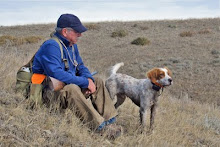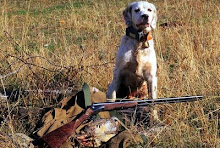 "Speargrass" is a term generally applied to several types of bromes or grasses (also called needlegrass, hayneedle, and foxtail) that produce awns that will create serious problems if ingested or lodged in ears, between the toes, or in the 'armpit' of a dogs. They have very hard, sharp points and barbs that cause them to travel through tissue and migrate through a dog's body. In the areas that I commonly hunt chukars, cheat grass produces awns of this type.
"Speargrass" is a term generally applied to several types of bromes or grasses (also called needlegrass, hayneedle, and foxtail) that produce awns that will create serious problems if ingested or lodged in ears, between the toes, or in the 'armpit' of a dogs. They have very hard, sharp points and barbs that cause them to travel through tissue and migrate through a dog's body. In the areas that I commonly hunt chukars, cheat grass produces awns of this type. Monday, July 20, 2009
Speargrass
 "Speargrass" is a term generally applied to several types of bromes or grasses (also called needlegrass, hayneedle, and foxtail) that produce awns that will create serious problems if ingested or lodged in ears, between the toes, or in the 'armpit' of a dogs. They have very hard, sharp points and barbs that cause them to travel through tissue and migrate through a dog's body. In the areas that I commonly hunt chukars, cheat grass produces awns of this type.
"Speargrass" is a term generally applied to several types of bromes or grasses (also called needlegrass, hayneedle, and foxtail) that produce awns that will create serious problems if ingested or lodged in ears, between the toes, or in the 'armpit' of a dogs. They have very hard, sharp points and barbs that cause them to travel through tissue and migrate through a dog's body. In the areas that I commonly hunt chukars, cheat grass produces awns of this type. Wednesday, July 15, 2009
SB250 beaten back for now...
I just got back from the Assembly Appropriations Committee hearing on SB 250. After about an hour of testimony and voting on several other bills, it was announced that Senator Dean Florez had withdrawn SB 250 and placed it in the "suspense " file. No supporters of the bill were present, as they must have been tipped off before hand. Two opposition spokespersons were allowed to speak, but only very briefly. An AKC representative spoke effectively about the adverse fiscal impact that would result from cancellation of all of the bench shows held in California. I can't remember what the NAIA representative had to say. Following that, the Committee Chairman, Kevin De Leon, asked if there were any supporters of SB 250 present (there were none) and then asked those who were opposed to SB 250 to stand. Nearly everyone present in the room then stood. However, none of us were allowed to announce our affiliations or to speak. I could not see how many were seated in the balcony, but there were about 100 to 150 people present in the room below the balcony where I was sitting. Nothing even close to the thousands present for the Senate Local Government hearing on AB 1634, in July of 2007!
Then, several DEMOCRATIC Assemblymembers rose to express opposition to the bill. One of them stated that he hoped that the people bringing these kinds of bills before the State Legislature would stop doing so. He also noted that these MSN options are available at the city and county level, and that it was inappropriate to deal with these issues at the statewide level.
I have to believe that the tide was turned against this bill by two events: (1) the June 9 story in the SF Chronicle about SB 250 having it's greatest impact on low income people, and (2) the release of the 2008 California Department of Public Health county animal shelter statistics, which showed that the increases in impounds and euthanasias were 11x higher in LA County than in all of the rest of the state put together.
This bill was very bad news for California dog owners. We hope that after this the bill will die, as did AB 1634 last year, and the subject of statewide mandatory spay and neuter will not arise again.
Shame on Senator Dean Florez for authoring and sponsoring this ill-informed, ignorant piece of legislation. The HSUS worked on this bill, and I believe may have actually authored or had substantial influence on it's creation. It certainly takes a page directly from their political playbook.








